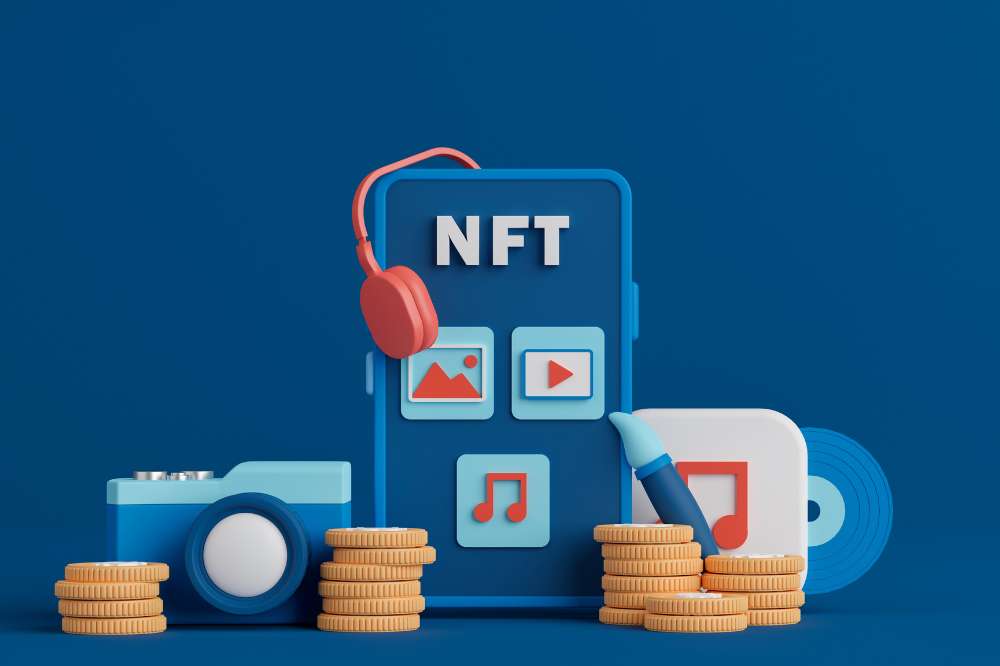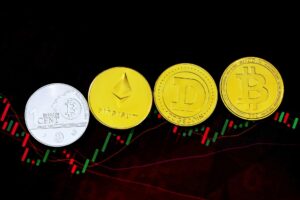Non-Fungible Tokens (NFTs) have taken the digital world by storm, captivating the attention of creators, collectors, and investors alike. As a beginner venturing into the realm of digital assets, understanding NFTs is essential to grasp the nuances of this rapidly evolving landscape.
In this starter guide, we’ll unravel the basics of NFTs, providing you with a comprehensive overview to kickstart your journey into the fascinating world of (NFTs) non-fungible tokens.
What are NFTs?

NFTs, short for Non-Fungible Tokens, are unique digital assets that represent ownership or proof of authenticity of a specific item or piece of content. Unlike cryptocurrencies such as Bitcoin or Ethereum, which are fungible and can be exchanged on a one-to-one basis, NFTs are indivisible and cannot be replicated. Each NFT is distinguishable from others and possesses distinct characteristics that make it one-of-a-kind.
No products found.
NFTs are built on blockchain technology, utilizing smart contracts to establish ownership rights and enable seamless transactions in a decentralized manner. These tokens have gained prominence across various industries, including art, music, gaming, collectibles, and virtual real estate, offering creators and collectors new avenues for expression, monetization, and engagement.
Examples of NFTs range from digital artworks and music albums to virtual real estate parcels and in-game items. Each NFT is associated with a unique identifier recorded on the blockchain, providing transparency, security, and authenticity to the digital asset.
As we delve deeper into the mechanics of NFTs, you’ll gain a better understanding of their significance and potential impact on the digital economy.
How Do NFTs Work?
NFTs operate on blockchain networks, leveraging the underlying technology to authenticate, tokenize, and trade digital assets. The process of creating, buying, selling, and transferring NFTs involves several key components and steps:
1. Tokenization:
- Creation: Creators mint NFTs by tokenizing digital assets using specialized platforms or marketplaces. This process involves transforming digital content, such as artwork, videos, or music, into unique tokens on the blockchain.
- Metadata: NFTs contain metadata that provides information about the digital asset, including its title, description, creator, and ownership history. This metadata is stored alongside the token on the blockchain, ensuring transparency and provenance.
2. Ownership and Transfer:
- Ownership: NFTs establish ownership rights through blockchain-based ownership records stored in smart contracts. Each NFT is associated with a unique digital signature, or token ID, which serves as proof of ownership.
- Transferability: Owners can transfer NFTs to other individuals by initiating transactions on blockchain networks. These transactions are recorded on the blockchain, updating ownership records and ensuring the integrity of the ownership chain.
3. Interoperability and Standards:
- Interoperability: NFTs adhere to interoperability standards, such as the ERC-721 and ERC-1155 standards on the Ethereum blockchain, enabling compatibility across different platforms and marketplaces.
- Smart Contracts: Smart contracts govern the behavior and functionality of NFTs, including ownership transfer, royalty distribution, and access control. These contracts execute predefined logic and rules encoded on the blockchain, automating processes and ensuring compliance with established protocols.
Benefits and Challenges of NFTs:
Benefits:
NFTs offer several advantages, making them a valuable tool for creators, collectors, and investors. Firstly, NFTs provide irrefutable proof of ownership and authenticity, thanks to their unique digital signatures stored on the blockchain.
This feature ensures that creators can establish ownership rights and track the provenance of their digital assets, reducing the risk of fraud and plagiarism.
Additionally, NFTs unlock new monetization opportunities for creators, allowing them to sell their digital creations directly to fans and collectors without intermediaries.
This direct relationship between creators and consumers fosters greater autonomy and financial independence in the creative industry.
Challenges:
Despite their potential, NFTs also face several challenges that need to be addressed for widespread adoption and scalability. One significant challenge is the high transaction fees, or gas fees, associated with blockchain networks, particularly during periods of high demand.
These fees can make it prohibitively expensive for creators and buyers to mint, buy, and trade NFTs, limiting accessibility and usability.
Additionally, scalability issues on blockchain networks, such as slow transaction times and network congestion, pose challenges for the widespread adoption of NFTs in mainstream applications.
Furthermore, concerns about copyright infringement and intellectual property rights in the NFT space highlight the need for clearer regulations and guidelines to protect creators and their work.
How to Get Started with NFTs
Getting started with NFTs is an exciting journey that opens up a world of possibilities for creators, collectors, and enthusiasts.
Here are some steps for beginners to start exploring and participating in the NFT ecosystem:
- Research and Education: Begin by researching different NFT projects, platforms, and marketplaces to understand their features, benefits, and communities. Educate yourself about the basics of blockchain technology, smart contracts, and token standards to make informed decisions.
- Choose a Marketplace: Select a reputable NFT marketplace that aligns with your interests and goals. Popular NFT marketplaces include OpenSea, Rarible, and Foundation, each offering unique features and collections across various categories.
- Create or Purchase an NFT: Decide whether you want to create your own NFTs or purchase existing ones from other creators. If you’re a creator, explore minting platforms that allow you to tokenize your digital creations and list them for sale on NFT marketplaces. Alternatively, browse existing collections and auctions to discover NFTs that resonate with you.
- Understand the Buying Process: Familiarize yourself with the buying process on NFT marketplaces, including how to connect your cryptocurrency wallet, place bids, and confirm transactions. Pay attention to transaction fees, gas prices, and network congestion, as they can affect your overall experience.
- Engage with the Community: Join NFT communities, forums, and social media channels to connect with other enthusiasts, share insights, and stay updated on the latest trends and developments in the NFT space. Engaging with the community can provide valuable insights and opportunities for collaboration and growth in the NFT ecosystem.
By following these steps and staying informed, you can embark on your journey into the exciting world of NFTs with confidence and curiosity, unlocking new opportunities for creativity, ownership, and participation in the digital economy.
Future Outlook of NFTs
The future of NFTs holds immense promise as these unique digital assets continue to reshape the digital landscape across various industries. As blockchain technology evolves and becomes more accessible, we can expect NFTs to play an increasingly significant role in sectors such as art, gaming, entertainment, real estate, and beyond.
Emerging trends such as fractionalized ownership, interoperability between different NFT platforms, and the integration of NFTs into virtual and augmented reality experiences are poised to drive further innovation and adoption.
Moreover, ongoing technological advancements and regulatory developments will shape the trajectory of NFTs, influencing their potential impact on creators, collectors, investors, and the broader digital economy.
Conclusion
This starter guide has provided a comprehensive overview of the basics of NFTs, empowering you to navigate the exciting world of non-fungible tokens with confidence and curiosity. From understanding what NFTs are and how they work to exploring their benefits, challenges, and future outlook, this guide has covered essential topics for newcomers to the NFT ecosystem.
As you embark on your journey into the world of NFTs, remember to continue learning, exploring, and engaging with the vibrant community of creators, collectors, and enthusiasts.
With their transformative potential to revolutionize ownership, creativity, and participation in the digital economy, NFTs offer boundless opportunities for innovation, expression, and growth in the years to come.



